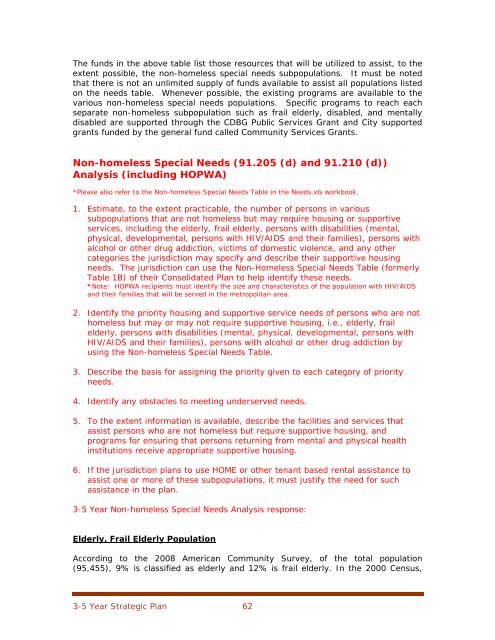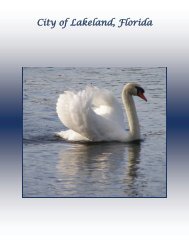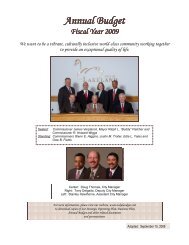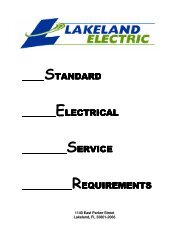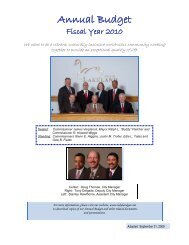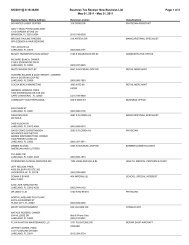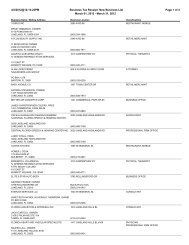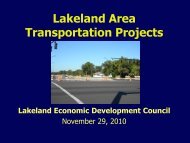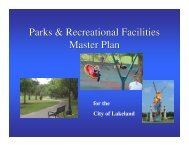CONSOLIDATED PLAN & STRATEGY 5-YEAR ... - City of Lakeland
CONSOLIDATED PLAN & STRATEGY 5-YEAR ... - City of Lakeland
CONSOLIDATED PLAN & STRATEGY 5-YEAR ... - City of Lakeland
Create successful ePaper yourself
Turn your PDF publications into a flip-book with our unique Google optimized e-Paper software.
The funds in the above table list those resources that will be utilized to assist, to the<br />
extent possible, the non-homeless special needs subpopulations. It must be noted<br />
that there is not an unlimited supply <strong>of</strong> funds available to assist all populations listed<br />
on the needs table. Whenever possible, the existing programs are available to the<br />
various non-homeless special needs populations. Specific programs to reach each<br />
separate non-homeless subpopulation such as frail elderly, disabled, and mentally<br />
disabled are supported through the CDBG Public Services Grant and <strong>City</strong> supported<br />
grants funded by the general fund called Community Services Grants.<br />
Non-homeless Special Needs (91.205 (d) and 91.210 (d))<br />
Analysis (including HOPWA)<br />
*Please also refer to the Non-homeless Special Needs Table in the Needs.xls workbook.<br />
1. Estimate, to the extent practicable, the number <strong>of</strong> persons in various<br />
subpopulations that are not homeless but may require housing or supportive<br />
services, including the elderly, frail elderly, persons with disabilities (mental,<br />
physical, developmental, persons with HIV/AIDS and their families), persons with<br />
alcohol or other drug addiction, victims <strong>of</strong> domestic violence, and any other<br />
categories the jurisdiction may specify and describe their supportive housing<br />
needs. The jurisdiction can use the Non-Homeless Special Needs Table (formerly<br />
Table 1B) <strong>of</strong> their Consolidated Plan to help identify these needs.<br />
*Note: HOPWA recipients must identify the size and characteristics <strong>of</strong> the population with HIV/AIDS<br />
and their families that will be served in the metropolitan area.<br />
2. Identify the priority housing and supportive service needs <strong>of</strong> persons who are not<br />
homeless but may or may not require supportive housing, i.e., elderly, frail<br />
elderly, persons with disabilities (mental, physical, developmental, persons with<br />
HIV/AIDS and their families), persons with alcohol or other drug addiction by<br />
using the Non-homeless Special Needs Table.<br />
3. Describe the basis for assigning the priority given to each category <strong>of</strong> priority<br />
needs.<br />
4. Identify any obstacles to meeting underserved needs.<br />
5. To the extent information is available, describe the facilities and services that<br />
assist persons who are not homeless but require supportive housing, and<br />
programs for ensuring that persons returning from mental and physical health<br />
institutions receive appropriate supportive housing.<br />
6. If the jurisdiction plans to use HOME or other tenant based rental assistance to<br />
assist one or more <strong>of</strong> these subpopulations, it must justify the need for such<br />
assistance in the plan.<br />
3-5 Year Non-homeless Special Needs Analysis response:<br />
Elderly, Frail Elderly Population<br />
According to the 2008 American Community Survey, <strong>of</strong> the total population<br />
(95,455), 9% is classified as elderly and 12% is frail elderly. In the 2000 Census,<br />
3-5 Year Strategic Plan 62


